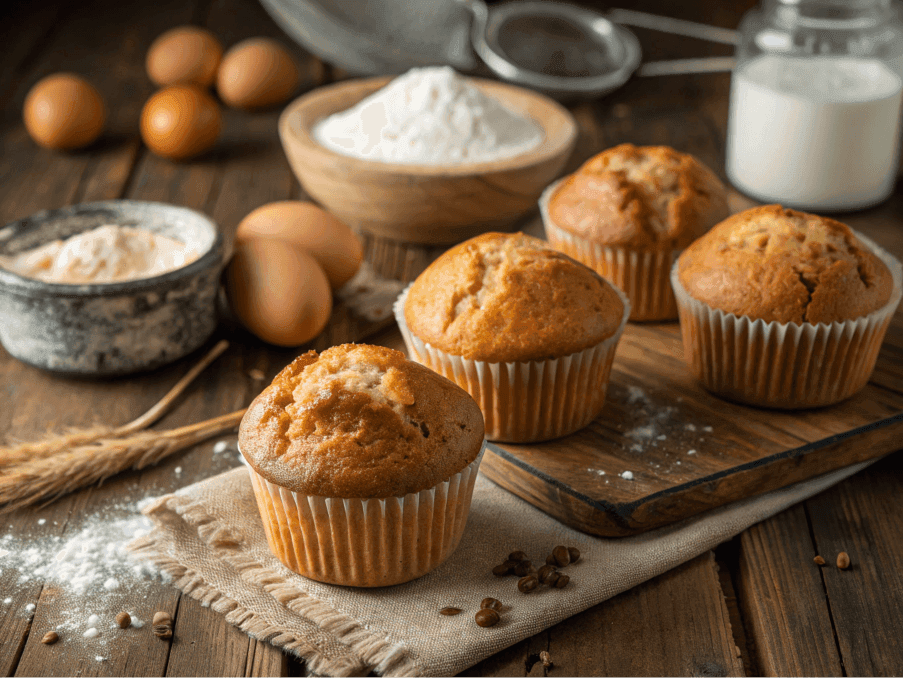Can I use kefir instead of milk in muffins? Baking enthusiasts often wonder about substituting ingredients to improve recipes or meet dietary preferences. Accordingly, a common question arises: Can kefir replace milk in muffins? Kefir, a fermented dairy product celebrated for its tangy flavor and impressive nutritional profile, serves as an excellent milk alternative. Its unique properties not only enhance the taste but also improve the texture of muffins. This article delves into the ways kefir can be used in muffins, highlighting its advantages while sharing essential tips for achieving perfectly moist and flavorful baked goods.
Table of contents
Why Kefir is the Perfect Milk Substitute for Baking Muffins
Kefir stands out among milk alternatives because of its unique properties, especially when used in baking. Not only is kefir a fantastic source of probiotics that support gut health, but it also brings a subtle tanginess that elevates the flavor of baked goods. Muffins made with kefir are exceptionally moist, tender, and flavorful, making them a favorite among bakers who want to swap traditional milk for a healthier and more versatile option.
Actionable Tip: Use plain, unsweetened kefir for savory muffins or flavored kefir like vanilla for a sweet twist.
Kefir’s slightly acidic nature reacts well with baking powder, helping muffins rise beautifully. It also creates a softer crumb compared to using milk. Unlike other substitutes like almond or soy milk, kefir closely mimics the consistency of regular milk, ensuring your batter isn’t too thin or thick.
To understand the broader benefits of using kefir in baking, explore What Does Kefir Do in Baking? Easy Recipes and Benefits.
How to Make Muffins with Kefir
Gathering Your Ingredients
Before starting, ensure you have fresh kefir and all the other essentials for baking. Below is a comprehensive list to guide you.
| Ingredient | Amount | Notes |
|---|---|---|
| All-purpose flour | 2 cups | Whole wheat flour can be substituted for added fiber. |
| Sugar | 1 cup | Adjust based on the sweetness of your kefir. |
| Baking powder | 2 teaspoons | Ensures proper rising of the batter. |
| Salt | 1/2 teaspoon | Balances out the flavors. |
| Kefir | 1 cup | Substitute directly for milk. |
| Eggs | 2 | Use large eggs for better structure. |
| Butter | 1/2 cup | Melted, adds richness and moisture. |
| Vanilla extract | 1 teaspoon | Optional, but enhances sweetness. |
Step-by-Step Instructions
- Prepare Your Workspace
Preheat the oven to 375°F (190°C) and line your muffin tin with paper liners or grease the wells lightly. Ensure all ingredients are at room temperature for better mixing. - Combine Dry Ingredients
In a large bowl, sift together the flour, sugar, baking powder, and salt. Sifting prevents clumps and ensures an even texture. - Mix Wet Ingredients
In another bowl, whisk together kefir, eggs, melted butter, and vanilla extract. Stir until smooth but avoid overmixing.

- Combine and Stir
Slowly pour the wet mixture into the dry ingredients. Use a spatula to fold the batter gently, stopping as soon as it’s combined. Overmixing can make the muffins dense. - Bake to Perfection
Spoon the batter evenly into the muffin tin. Fill each well about ¾ full to allow room for rising. Bake for 18–22 minutes or until a toothpick inserted in the center comes out clean.

- Cool and Enjoy
Let the muffins cool in the pan for 5 minutes before transferring them to a wire rack. Serve warm or store in an airtight container for up to three days.
Can I Use Kefir Instead of Milk in Muffins? Pro Tips for Perfect Results
Tip 1: Let the Batter Rest
Allowing the batter to rest for 10 minutes before baking can make a significant difference in your muffins. This resting period helps the gluten in the flour relax, resulting in lighter and fluffier muffins. Whether you’re using kefir or traditional milk, this step ensures your muffins have the perfect texture.
Tip 2: Experiment with Add-Ins
Customizing your muffins is easy when you experiment with mix-ins like blueberries, chocolate chips, or nuts. These additions add bursts of flavor and texture to your muffins, making each bite more enjoyable. Using flavored kefir, such as vanilla or berry, not only enhances the richness of these mix-ins but also brings out a unique tanginess that pairs perfectly with the sweetness of the muffins. Whether you’re baking for a special occasion or simply trying something new, kefir and creative mix-ins can transform your muffins into a truly delightful treat.
For more creative ways to bake with kefir, explore Kefir vs. Yogurt Cake.
What Makes Kefir Unique in Baking?
The magic of kefir lies in its remarkable composition. Accordingly, it serves as an excellent substitute for milk in baking muffins. Rich in lactic acid bacteria and natural enzymes, it interacts with baking powder. Consequently, it creates air pockets that help muffins rise beautifully. Moreover, its tanginess complements the sweetness of sugar. Therefore, it delivers a perfectly balanced flavor that elevates the overall taste of your kefir muffins.
Unlike other dairy substitutes, kefir’s thicker consistency ensures the batter isn’t runny. It also provides a creamy texture that enhances the moistness of muffins.
Fun Fact: The live cultures in kefir may not survive high baking temperatures, but its nutritional benefits remain intact.

Mistakes to Avoid When Baking with Kefir
Mistake 1: Using Expired Kefir
Using fresh kefir is essential for achieving the best taste and consistency in your muffins. Expired kefir can become overly sour, which may overpower the flavors in your muffins and lead to an unpleasant baking experience. Always check the expiration date before adding kefir to your muffin batter to ensure optimal results.
Mistake 2: Overmixing the Batter
One of the most common baking mistakes is overmixing, and this holds true when baking muffins with kefir as a substitute for milk. Overmixing can result in dense and chewy muffins, as it overworks the gluten in the flour. To avoid this, mix just until the dry and wet ingredients, including the kefir, are combined to maintain a light and fluffy texture.
Mistake 3: Forgetting to Adjust Sweetness
If you’re using flavored kefir, such as strawberry or vanilla, it’s crucial to consider the added sweetness it brings to your muffins. Failing to adjust the sugar in your recipe can result in muffins that are overly sweet and lose their balance of flavors. To avoid this, taste the flavored kefir beforehand and reduce the sugar accordingly. This adjustment ensures your kefir muffins achieve the perfect harmony of sweetness and tanginess, making them a delightful alternative to traditional milk-based recipes.
Health Benefits of Using Kefir
Beyond its baking benefits, kefir is a nutritional powerhouse packed with probiotics, vitamins, and minerals. It enhances the health value of muffins, offering digestive support, immune boosts, and better nutrient absorption.
Digestive Health
Kefir’s probiotics promote gut balance, aiding digestion and reducing bloating. Its enzymes also help break down lactose, making it easier to digest for those with lactose intolerance.
Immune System Support
Though baking kills live probiotics, kefir retains immune-boosting compounds like bioactive peptides, antioxidants, selenium, and zinc, helping strengthen the body’s defenses.
Improved Nutrient Absorption
Kefir improves the absorption of essential nutrients like calcium, magnesium, and vitamin D, supporting bone health, muscle function, and overall well-being.
Weight Management and Metabolic Health
High in protein and low in calories, kefir helps with weight management by promoting fullness. Its probiotics may also support metabolic balance.
Heart Health
Bioactive peptides in kefir may help lower blood pressure, while its nutrient-rich profile supports cardiovascular wellness.
Antioxidant Properties
Kefir’s antioxidants combat free radicals, reducing oxidative stress and promoting long-term health.
Incorporating kefir into your baking not only enhances texture and flavor but also boosts nutrition, making your muffins both delicious and beneficial.
Baking Your Muffins to Perfection
With your muffin batter ready, it’s time to bake! Baking may seem straightforward, but there are critical steps to ensure your muffins turn out moist, fluffy, and evenly cooked.
Critical Baking Tips
- Positioning Matters
Place the muffin tin in the center of your oven to guarantee even heat distribution. This prevents some muffins from browning too quickly while others remain undercooked. - Check Early for Doneness
Start checking your muffins at the 18-minute mark. Insert a toothpick into the center of a muffin; if it comes out clean, they’re ready. Overbaking can lead to dryness, so keep a close eye. - Cooling is Key
Let the muffins cool in the tin for five minutes, then transfer them to a wire rack. Cooling allows the structure to set, preventing the muffins from crumbling.

Pro Tips for Muffin Success
Even seasoned bakers encounter challenges, but these pro tips will help you avoid common pitfalls and enhance your baking experience.
Avoid Overmixing
Overmixing the batter can lead to dense muffins. Stir gently until the dry ingredients are just incorporated with the wet mixture. A few lumps in the batter are perfectly fine.
Let the Batter Rest
Allowing the batter to rest for 10 minutes before baking can result in softer, fluffier muffins. This step lets the flour hydrate fully and the baking powder activate.
Experiment with Flavored Kefir
While plain kefir is versatile, flavored varieties like vanilla or berry can add depth to your muffins. Adjust the sugar accordingly to prevent them from becoming too sweet.
For more creative ways to use kefir in baking, check out Use Kefir Instead of Buttermilk.
Variations to Try
Kefir’s unique tangy flavor makes it an excellent base for creative muffin recipes. Below are three variations to inspire your next bake.
Berry Delight Muffins
Fold in 1 cup of fresh or frozen berries such as blueberries, raspberries, or blackberries. These add bursts of flavor and juiciness, balancing the tang of kefir.
Zesty Lemon Muffins
Add 1 tablespoon of lemon zest and 1 teaspoon of lemon extract to the batter. The citrus notes pair beautifully with kefir’s acidity, creating a light and refreshing treat.
Savory Cheese Muffins
Reduce the sugar to 2 tablespoons and mix in ½ cup of grated cheddar cheese and a pinch of smoked paprika. These muffins are perfect for breakfast or alongside soups.
For another way to enjoy kefir’s nutritional benefits, visit Kefir Sheet Cake.
FAQs: Common Questions About Baking with Kefir
Can you substitute kefir for milk in baking?
Yes, kefir is a fantastic one-to-one substitute for milk in baking. It enhances the texture and flavor of muffins by adding moisture and a subtle tang.
Is kefir a good substitute for milk?
Absolutely. Kefir offers probiotics and a creamy consistency similar to milk. It’s particularly useful in recipes that benefit from a slightly acidic ingredient.
Can you use kefir like milk?
Yes, kefir can replace milk in most recipes. However, its tangy taste may alter the flavor profile, so it’s best suited for baked goods, pancakes, or savory dishes.
Does heat destroy kefir?
Heat kills the live probiotics in kefir, but its nutritional components like protein, calcium, and vitamins remain intact.
Checklist for Muffin Perfection
Before you start baking, use this checklist to ensure success:
- Ingredients Ready: Ensure all ingredients are fresh and measured accurately.
- Tools Prepared: Preheat the oven and grease or line your muffin tin.
- No Overmixing: Combine ingredients gently to avoid dense muffins.
- Timing Monitored: Set a timer to check muffins early for doneness.
- Cooling Time: Allow muffins to cool properly before serving.
Conclusion
Using kefir instead of milk in muffins isn’t just a substitution—it’s an upgrade. From its nutritional benefits to its unique flavor, kefir enhances every aspect of baking. In fact, kefir’s probiotics and fermentation process contribute to improved digestion and better nutrient absorption (as detailed by the National Institutes of Health). By following this guide, you can create muffins that are not only delicious but also healthier and more versatile. Whether you stick to a classic recipe or try one of the variations, baking with kefir is a choice you won’t regret.

